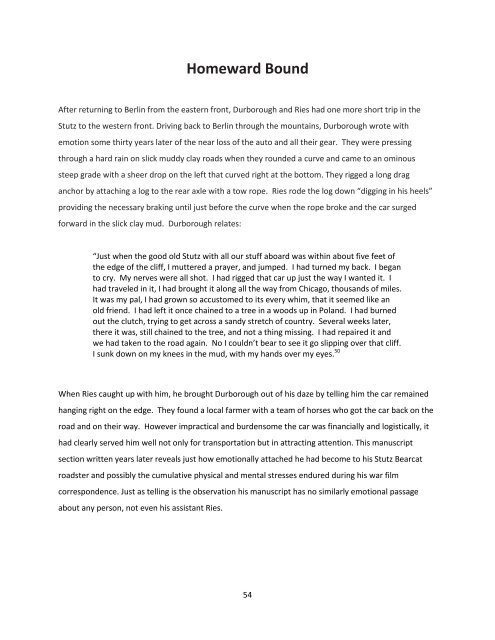"On the Firing Line with the Germans" Film Annotations (2017)
Film annotations, describing the making of Wilbur H. Durborough's World War I feature film "On the Firing Line with the Germans (USA, 1915) by authors Cooper C. Graham, Ron van Dopperen and James W. Castellan (April 2017). For more information visit our weblog http://shootingthegreatwar.blogspot.nl The movie can be watched on our YouTube channel: https://youtu.be/958QR_Cdg5U
Film annotations, describing the making of Wilbur H. Durborough's World War I feature film "On the Firing Line with the Germans (USA, 1915) by authors Cooper C. Graham, Ron van Dopperen and James W. Castellan (April 2017).
For more information visit our weblog http://shootingthegreatwar.blogspot.nl
The movie can be watched on our YouTube channel:
https://youtu.be/958QR_Cdg5U
Create successful ePaper yourself
Turn your PDF publications into a flip-book with our unique Google optimized e-Paper software.
Homeward Bound<br />
After returning to Berlin from <strong>the</strong> eastern front, Durborough and Ries had one more short trip in <strong>the</strong><br />
Stutz to <strong>the</strong> western front. Driving back to Berlin through <strong>the</strong> mountains, Durborough wrote <strong>with</strong><br />
emotion some thirty years later of <strong>the</strong> near loss of <strong>the</strong> auto and all <strong>the</strong>ir gear. They were pressing<br />
through a hard rain on slick muddy clay roads when <strong>the</strong>y rounded a curve and came to an ominous<br />
steep grade <strong>with</strong> a sheer drop on <strong>the</strong> left that curved right at <strong>the</strong> bottom. They rigged a long drag<br />
anchor by attaching a log to <strong>the</strong> rear axle <strong>with</strong> a tow rope. Ries rode <strong>the</strong> log down “digging in his heels”<br />
providing <strong>the</strong> necessary braking until just before <strong>the</strong> curve when <strong>the</strong> rope broke and <strong>the</strong> car surged<br />
forward in <strong>the</strong> slick clay mud. Durborough relates:<br />
“Just when <strong>the</strong> good old Stutz <strong>with</strong> all our stuff aboard was <strong>with</strong>in about five feet of<br />
<strong>the</strong> edge of <strong>the</strong> cliff, I muttered a prayer, and jumped. I had turned my back. I began<br />
to cry. My nerves were all shot. I had rigged that car up just <strong>the</strong> way I wanted it. I<br />
had traveled in it, I had brought it along all <strong>the</strong> way from Chicago, thousands of miles.<br />
It was my pal, I had grown so accustomed to its every whim, that it seemed like an<br />
old friend. I had left it once chained to a tree in a woods up in Poland. I had burned<br />
out <strong>the</strong> clutch, trying to get across a sandy stretch of country. Several weeks later,<br />
<strong>the</strong>re it was, still chained to <strong>the</strong> tree, and not a thing missing. I had repaired it and<br />
we had taken to <strong>the</strong> road again. No I couldn’t bear to see it go slipping over that cliff.<br />
I sunk down on my knees in <strong>the</strong> mud, <strong>with</strong> my hands over my eyes. 50<br />
When Ries caught up <strong>with</strong> him, he brought Durborough out of his daze by telling him <strong>the</strong> car remained<br />
hanging right on <strong>the</strong> edge. They found a local farmer <strong>with</strong> a team of horses who got <strong>the</strong> car back on <strong>the</strong><br />
road and on <strong>the</strong>ir way. However impractical and burdensome <strong>the</strong> car was financially and logistically, it<br />
had clearly served him well not only for transportation but in attracting attention. This manuscript<br />
section written years later reveals just how emotionally attached he had become to his Stutz Bearcat<br />
roadster and possibly <strong>the</strong> cumulative physical and mental stresses endured during his war film<br />
correspondence. Just as telling is <strong>the</strong> observation his manuscript has no similarly emotional passage<br />
about any person, not even his assistant Ries.<br />
54



